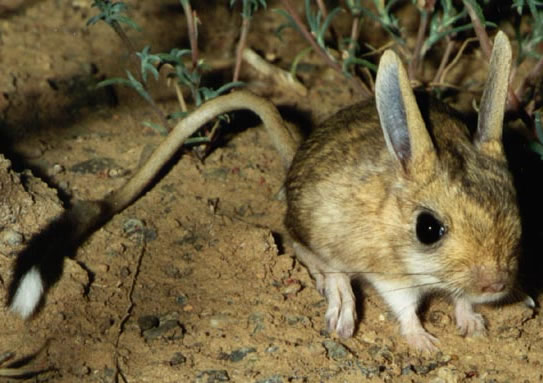
Small five-toed jerboa (Allactaga elater)
Phylum — chordata
Class — mammalia
Order — rodentia
Family — dipodidae
Genus – allactaga
Appearance
The jerboa body length ranges from 5–15 cm and has a tail ranging from 7–25 cm. They have large ears in comparison to their body size and a large tail. The tail assists and serves as support when the jerboa is standing upright.
The male jerboa is usually larger in size and weight in comparison to the female jerboa. The pelt of the jerboa is either silky or velvety in texture and light in color.
Habitat
Small five-toed jerboa is most commonly found in eastern Asia Minor and the lower Volga River to Sinkiang and western Pakistan.
Behavior
Small five-toed jerboa typically travels on its hind legs. They use their tails to prop themselves up and for balance when jumping. They are able to cover up to 3 meters in a single bound. They are nocturnal rodents and are normally solitary. They burrow into the ground during the day and emerge at night to find food. This species does not hibernate during the winter because of the mild climate it inhabits.
Diet
Allactaga elater obtains its food by burrowing in the sand or soil. They generally feed on seeds, insects and the succulent parts of plants. They do not require free water in nature or captivity because they obtain sufficient amounts in their food.
Reproduction
Females give birth twice each year. The young are born in an average litter size of three. The gestation period for these small rodents is short, ranging from twenty days to four weeks. After birth, the mother stays with her young for several months to protect and teach them until they are old enough to fend for themselves in the wild. The young reach sexual maturity in six weeks.
The typical lifespan of a jerboa is around six years.
In captivity
Keep jerboa in a cage or a terrarium. It will be more interesting to watch them in a terrarium, where the desert landscape is reproduced for them. You can change the animals` day and night for the convenience of observing them, at night the cage is illuminated with daylight, and in the day - red. At the bottom of the terrarium or the cage the owner should place a calcined sand layer of 3 cm. The cleanliness of the sand should be monitored. It is not recommended to let the animal go out of the cage, as it will immediately hide under the furniture, and at night it will gnaw and dig up the wall.
The animals need a sand bath. The toilet for animals is arranged in one particular place, so it is not difficult to monitor the cleanliness.
Nests are arranged in small flower pots, you can place there pieces of pipes (not iron). The material for the nest is hay. Preparing for hibernation is the same as for ground squirrels. It`s better to keep animals in couples. In good conditions they breed in captivity.
Jerboa are fed with seeds of cultivated and wild cereals, sunflowers, beets, adult insects and their larvae, as well as crackers from white bread. Jerboa drink a little.
 Russian
Russian
 English
English
























